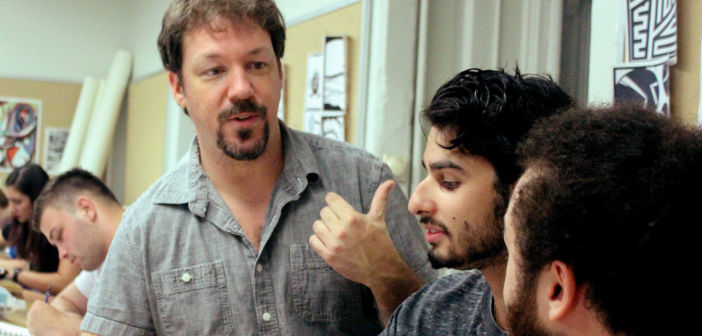Jason Travers stands at the front of the art studio, explaining to his students the criteria of their next project.
He shows them examples from his previous classes. As he looks at the old art, his eyes light up. He laughs as he explains the concepts behind each of the example pieces, remembering every detail his past students had told him about their pieces.
It is almost as if the works of art are communicating with him, each one with a new story and creation process.
As the class begins to work, Travers floats around the room, providing comments and suggestions on each student’s art. As he talks to each student, not only does he inspire them, but they inspire him.
“I have some students that I see their work and I see what they’re doing, and it makes me want to go home and and paint,” Travers said.
But teaching wasn’t always his passion.
As a young adult, Travers wanted to do something creative. Throughout high school, he participated in art courses where he did everything from painting to jewelry making. In college, Travers primarily focused on graphic design. As an art major, he was also required to take many studio courses, including drawing and painting.
“I had an instructor there that really kind of inspired or fueled the desire to get into the studio, and a lot of it came from a kind of new approach to drawing that to me was less meticulous and tedious and was more about pure expression, so that really kind of changed my direction,” he said.
Travers finished his undergraduate degree in graphic design and decided he wanted to go back to graduate school for painting. He attended University of Pennsylvania for a degree in fine arts. However, he soon realized he was going to have to change his whole artistic outlook to be successful in graduate school.
“When I got to graduate school, I really got beat up pretty good as far as my knowledge of art history and the foundations of design,” Travers said. “I think I was really fueled in the studio on this pure passion — just do it don’t think about stuff.”
He even received a letter from the art department chairs, with one line reading: “The faculty has noticed a strange sense of superficiality in the work that you’re doing.” Travers started to question his art.
Rather than focusing on quantity of work, he spent time trying to create work with meaning behind it. Travers became fascinated by the characters he created through abstraction and the interplay of these characters with structural elements.
This shaped his future and ultimately guided him to become a professor. Travers said while he was in school, he remembers his design foundation classes being filler courses and didn’t feel like they were well thought out or insightful.
Because of this, Travers wanted to make sure students were receiving valuable information in their foundation classes. In his classes, Travers tries to push his students to see reasoning behind each project and understand why it is assigned. He wants to make sure his students don’t feel like they are just cranking out pieces for no apparent reason.
Travers’ students say he is doing well. Elizabeth Anderson, ’19, has taken both drawing and 2-D design with Travers. She said Travers is her favorite professor.
“He helps everybody develop their own style,” Anderson said. “He helps you realize what things you’re good at and how to play to your strengths, and he’s really helped me develop as an artist.”
Hadi El Kebbi, ’19, took Travers’ 2-D design class in the fall semester, and also feels that Travers has made an impact on him.
“As artists, we’re always bound to the idea that if you’re good at drawing then you’re a good artist and if you’re bad at drawing then you’re not, but he’s helped me realize that being able to draw realistically is only one small grain of sand in the entire spectrum that is art,” he said.
This kind of response is exactly what Travers was hoping to achieve.
“To see that passion and energy, partially because Lehigh people are so conservative and afraid to step out and have a real sense of self and what they’re doing,” he said. “They want to make everything perfect, so it’s exciting to see that we get some genuine people coming through here.”






Comment policy
Comments posted to The Brown and White website are reviewed by a moderator before being approved. Incendiary speech or harassing language, including comments targeted at individuals, may be deemed unacceptable and not published. Spam and other soliciting will also be declined.
The Brown and White also reserves the right to not publish entirely anonymous comments.
1 Comment
Pingback: Jason Travers teaches the art of foundations – Media News